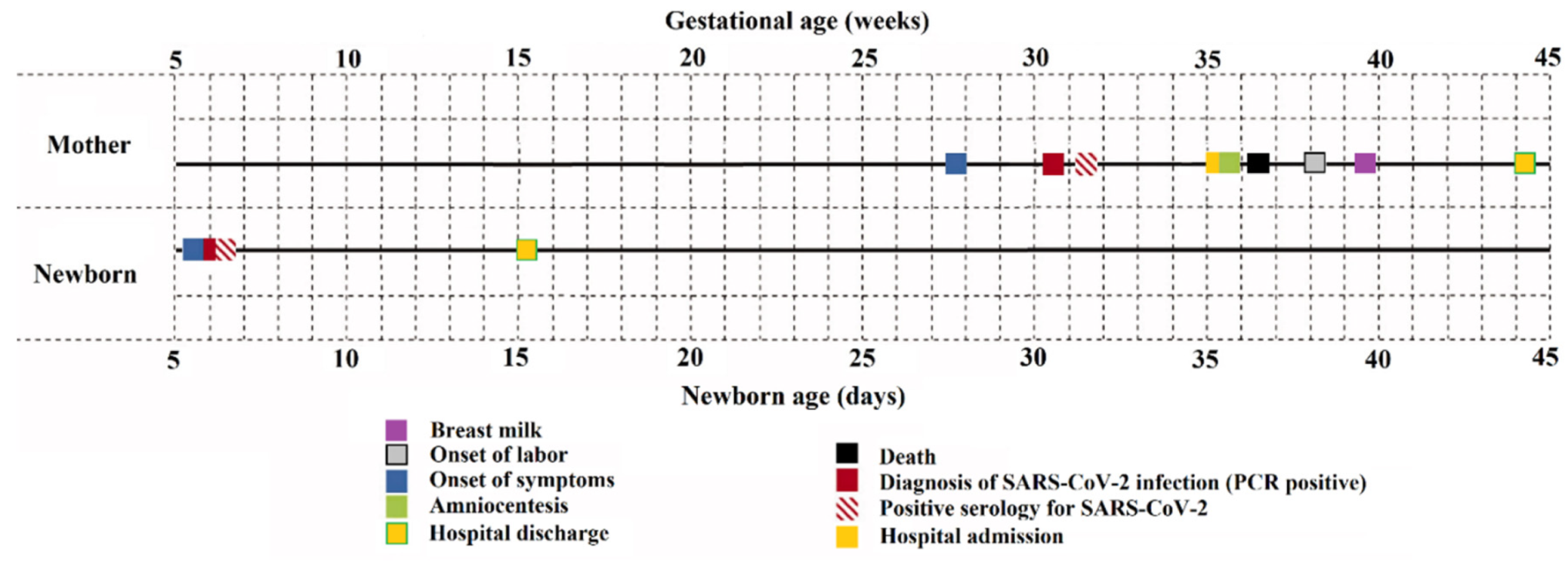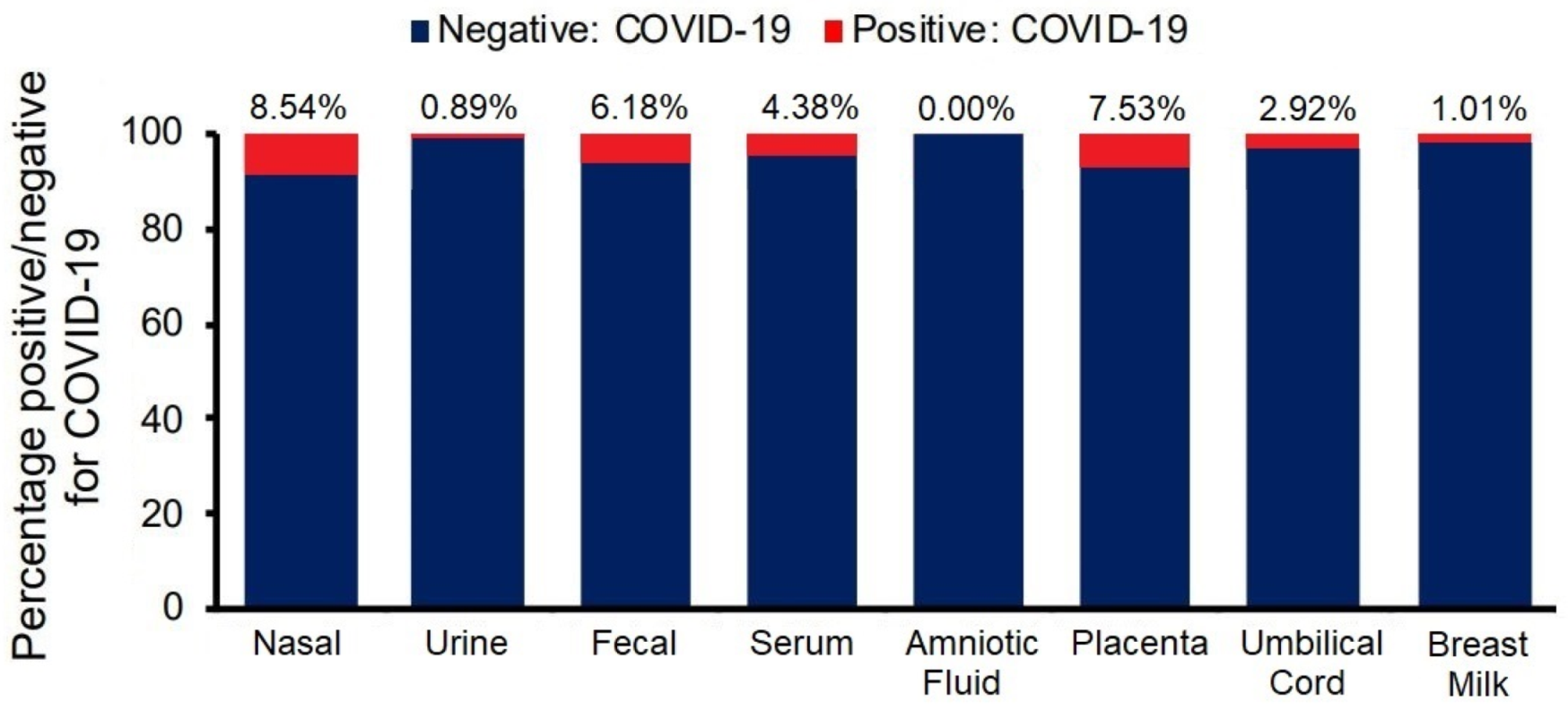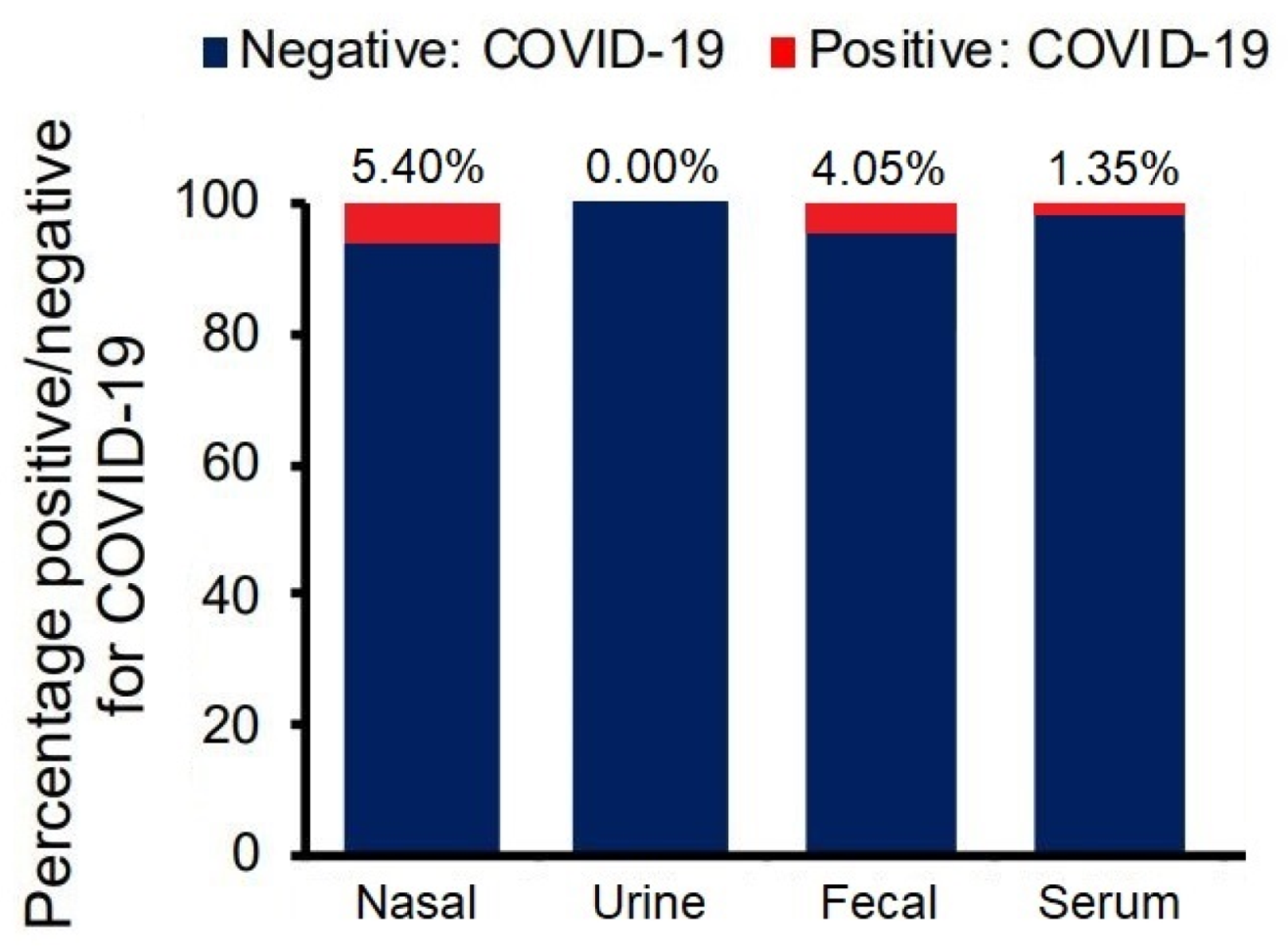Assessing SARS-CoV-2 Vertical Transmission and Neonatal Complications
Abstract
:1. Introduction
2. Materials and Methods
3. Results
4. Discussion
5. Conclusions
Author Contributions
Funding
Institutional Review Board Statement
Informed Consent Statement
Data Availability Statement
Conflicts of Interest
References
- Ritchie, H.; Mathieu, E.; Rodés-Guirao, L.; Appel, C.; Giattino, C.; Ortiz-Ospina, E.; Hasell, J.; MacDonald, B.; Beltekian, D.; Dattani, S.; et al. Coronavirus Pandemic (COVID-19). Our World in Data. 2021. Available online: https://ourworldindata.org/coronavirus (accessed on 20 September 2021).
- Li, P.; Wang, Y.; Peppelenbosch, M.P.; Ma, Z.; Pan, Q. Systematically comparing COVID-19 with the 2009 influenza pandemic for hospitalized patients. Int. J. Infect. Dis. 2021, 102, 375–380. [Google Scholar] [CrossRef] [PubMed]
- Team, E. The Epidemiological Characteristics of an Outbreak of 2019 Novel Coronavirus Diseases (COVID-19)—China, 2020. China CDC Wkly. 2020, 2, 113–122. [Google Scholar] [CrossRef]
- Gelardi, M.; Notargiacomo, M.; Trecca, E.M.; Cassano, M.; Ciprandi, G. COVID-19 and Nasal Cytobrush Cytology. Acta Cytol. 2020, 64, 397–398. [Google Scholar] [CrossRef]
- Maniaci, A.; Iannella, G.; Vicini, C.; Pavone, P.; Nunnari, G.; Falsaperla, R.; Di Mauro, P.; Ferlito, S.; Cocuzza, S. A Case of COVID-19 with Late-Onset Rash and Transient Loss of Taste and Smell in a 15-Year-Old Boy. Am. J. Case Rep. 2020, 21, e925813. [Google Scholar] [CrossRef] [PubMed]
- Zhang, L.; Jiang, Y.; Wei, M.; Cheng, B.H.; Zhou, X.C.; Li, J.; Tian, J.H.; Dong, L.; Hu, R.H. Analysis of the pregnancy outcomes in pregnant women with COVID-19 in Hubei Province. Zhonghua Fu Chan Ke Za Zhi 2020, 55, 166–171. [Google Scholar] [PubMed]
- Wen, R.; Sun, Y.; Xing, Q.S. A patient with SARS-CoV-2 infection during pregnancy in Qingdao, China. J. Microbiol. Immunol. Infect 2020, 53, 499–500. [Google Scholar] [CrossRef] [PubMed]
- Villar, J.; Ariff, S.; Gunier, R.B.; Thiruvengadam, R.; Rauch, S.; Kholin, A.; Roggero, P.; Prefumo, F.; Vale, M.S.D.; Cardona-Perez, J.A.; et al. Maternal and Neonatal Morbidity and Mortality among Pregnant Women with and without COVID-19 Infection: The INTERCOVID Multinational Cohort Study. JAMA Pediatr. 2021, 175, 817–826. [Google Scholar] [CrossRef]
- Vale, A.J.M.; Fernandes, A.C.L.; Guzen, F.P.; Pinheiro, F.I.; de Azevedo, E.P.; Cobucci, R.N. Susceptibility to COVID-19 in Pregnancy, Labor, and Postpartum Period: Immune System, Vertical Transmission, and Breastfeeding. Front. Glob. Women’s Health 2021, 2, 8. [Google Scholar] [CrossRef]
- Thomas, P.; Alexander, P.E.; Ahmed, U.; Elderhorst, E.; El-Khechen, H.; Mammen, M.J.; Debono, V.B.; Torres, Z.A.; Aryal, K.; Brocard, E.; et al. Vertical transmission risk of SARS-CoV-2 infection in the third trimester: A systematic scoping review. J. Matern. Neonatal Med. 2020, 1–8. [Google Scholar] [CrossRef]
- Timircan, M.; Bratosin, F.; Vidican, I.; Suciu, O.; Tirnea, L.; Avram, V.; Marincu, I. Exploring Pregnancy Outcomes Associated with SARS-CoV-2 Infection. Medicina 2021, 57, 796. [Google Scholar] [CrossRef]
- Di Mascio, D.; Buca, D.; Berghella, V.; Khalil, A.; Rizzo, G.; Odibo, A.; Saccone, G.; Galindo, A.; Liberati, M.; D’Antonio, F. Counseling in maternal–fetal medicine: SARS-CoV-2 infection in pregnancy. Ultrasound Obstet. Gynecol. 2021, 57, 687–697. [Google Scholar] [CrossRef]
- Piedimonte, G.; Walton, C.; Samsell, L. Vertical Transmission of Respiratory Syncytial Virus Modulates Pre- and Postnatal Innervation and Reactivity of Rat Airways. PLoS ONE 2013, 8, e61309. [Google Scholar] [CrossRef] [Green Version]
- Schwartz, D.A.; Graham, A.L. Potential Maternal and Infant Outcomes from Coronavirus 2019-nCoV (SARS-CoV-2) Infecting Pregnant Women: Lessons from SARS, MERS, and Other Human Coronavirus Infections. Viruses 2020, 12, 194. [Google Scholar] [CrossRef] [Green Version]
- Megli, C.J.; Coyne, C.B. Infections at the maternal–fetal interface: An overview of pathogenesis and defence. Nat. Rev. Genet. 2021, 25, 1–16. [Google Scholar] [CrossRef] [PubMed]
- Akhtar, H.; Patel, C.; Abuelgasim, E.; Harky, A. COVID-19 (SARS-CoV-2) Infection in Pregnancy: A Systematic Review. Gynecol. Obstet. Investig. 2020, 85, 295–306. [Google Scholar] [CrossRef]
- Costa, S.; Posteraro, B.; Marchetti, S.; Tamburrini, E.; Carducci, B.; Lanzone, A.; Valentini, P.; Buonsenso, D.; Sanguinetti, M.; Vento, G.; et al. Excretion of SARS-CoV-2 in human breast milk. Clin. Microbiol. Infect. 2020, 26, 1430–1432. [Google Scholar] [CrossRef] [PubMed]
- Galang, R.R.; Chang, K.; Strid, P.; Snead, M.C.; Woodworth, K.R.; House, L.D.; Perez, M.; Barfield, W.D.; Meaney-Delman, D.; Jamieson, D.J.; et al. Severe Coronavirus Infections in Pregnancy. Obstet. Gynecol. 2020, 136, 262–272. [Google Scholar] [CrossRef]
- Vivanti, A.J.; Vauloup-Fellous, C.; Prevot, S.; Zupan, V.; Suffee, C.; Do Cao, J.; Benachi, A.; De Luca, D. Transplacental transmission of SARS-CoV-2 infection. Nat. Commun. 2020, 11, 1–12. Available online: http://www.nature.com/articles/s41467-020-17436-6 (accessed on 20 September 2021). [CrossRef] [PubMed]
- Breslin, N.; Baptiste, C.; Gyamfi-Bannerman, C.; Miller, R.; Martinez, R.; Bernstein, K.; Ring, L.; Landau, R.; Purisch, S.; Friedman, A.M.; et al. Coronavirus disease 2019 infection among asymptomatic and symptomatic pregnant women: Two weeks of confirmed presentations to an affiliated pair of New York City hospitals. Am. J. Obstet. Gynecol. MFM 2020, 2, 100118. [Google Scholar] [CrossRef] [PubMed]
- Badr, D.A.; Mattern, J.; Carlin, A.; Cordier, A.-G.; Maillart, E.; El Hachem, L.; El Kenz, H.; Andronikof, M.; De Bels, D.; Damoisel, C.; et al. Are clinical outcomes worse for pregnant women at ≥20 weeks’ gestation infected with coronavirus disease 2019? A multicenter case-control study with propensity score matching. Am. J. Obstet. Gynecol. 2020, 223, 764–768. Available online: https://linkinghub.elsevier.com/retrieve/pii/S0002937820307766 (accessed on 20 September 2021).
- Mendoza, M.; Garcia-Ruiz, I.; Maiz, N.; Rodo, C.; Garcia-Manau, P.; Serrano, B.; Lopez-Martinez, R.M.; Balcells, J.; Fernandez-Hidalgo, N.; Carreras, E.; et al. Pre-eclampsia-like syndrome induced by severe COVID-19: A prospective observational study. BJOG Int. J. Obstet. Gynaecol. 2020, 127, 1374–1380. [Google Scholar] [CrossRef]
- Juan, J.; Gil, M.M.; Rong, Z.; Zhang, Y.; Yang, H.; Poon, L.C. Effect of coronavirus disease 2019 (COVID-19) on maternal, perinatal and neonatal outcome: Systematic review. Ultrasound Obstet. Gynecol. 2020, 56, 15–27. [Google Scholar] [CrossRef]
- WHO Scientific Brief 2021. Definition and Categorization of the Timing of Mother-to-Child Transmission of SARS-CoV-2. Available online: http://WHO/2019-nCoV/mother-to-child_transmission/2021.1 (accessed on 20 September 2021).
- Blumberg, D.A.; Underwood, M.A.; Hedriana, H.; Lakshminrusimha, S. Vertical Transmission of SARS-CoV-2: What is the Optimal Definition? Am. J. Perinatol. 2020, 37, 769–772. [Google Scholar] [CrossRef] [PubMed]
- Knight, M.; Bunch, K.; Vousden, N.; Morris, E.; Simpson, N.; Gale, C.; O’Brien, P.; Quigley, M.; Brocklehurst, P.; Kurinczuk, J.J. Characteristics and outcomes of pregnant women admitted to hospital with confirmed SARS-CoV-2 infection in UK: National population based cohort study. BMJ 2020, 369, m2107. [Google Scholar] [CrossRef] [PubMed]
- Spinato, G.; Gaudioso, P.; Rizzo, P.B.; Fabbris, C.; Menegaldo, A.; Mularoni, F.; Singh, B.; Maniaci, A.; Cocuzza, S.; Frezza, D. Risk management during COVID-19: Safety procedures for otolaryngologists. Acta Biomed. 2021, 92, e2021105. [Google Scholar] [CrossRef]
- Romanian Health Ministry. Methodology Regarding the Birth of Pregnant Women with Suspected/Confirmed Sars-Cov-2 Infection. Updated 26 October 2020. Available online: http://www.ms.ro/wp-content/uploads/2020/11/Metodologia-privind-na%C8%99terea-la-gravidele-cu-infec%C8%9Bie-suspicionat%C4%83-confirmat%C4%83-cu-SARS-COV-2_Revi.pdf (accessed on 20 September 2021).
- Lees, C.; Stampalija, T.; Baschat, A.A.; da Silva Costa, F.; Ferrazzi, E.; Figueras, F.; Hecher, K.; Kingdom, J.; Poon, L.C.; Salomon, L.J.; et al. Practice Guidelines: Diagnosis and management of small-for-gestational-age fetus and fetal growth restriction. Ultrasound Obstet. Gynecol. 2020, 56, 298–312. [Google Scholar] [CrossRef]
- Chen, H.; Guo, J.; Wang, C.; Luo, F.; Yu, X.; Zhang, W.; Li, J.; Zhao, D.; Xu, D.; Gong, Q.; et al. Clinical characteristics and intrauterine vertical transmission potential of COVID-19 infection in nine pregnant women: A retrospective review of medical records. Lancet 2020, 395, 809–815. [Google Scholar] [CrossRef] [Green Version]
- Centeno-Tablante, E.; Medina-Rivera, M.; Finkelstein, J.L.; Rayco-Solon, P.; Garcia-Casal, M.N.; Rogers, L.; Ghezzi-Kopel, K.; Ridwan, P.; Peña-Rosas, J.P.; Mehta, S. Transmission of SARS-CoV-2 through breast milk and breastfeeding: A living systematic review. Ann. N. Y. Acad. Sci. 2021, 1484, 32–54. [Google Scholar] [CrossRef] [PubMed]
- Tolu, L.B.; Ezeh, A.; Feyissa, G.T. Vertical transmission of Severe Acute Respiratory Syndrome Coronavirus 2: A scoping review. PLoS ONE 2021, 16, e0250196. [Google Scholar] [CrossRef] [PubMed]
- Pluddemann, A.; Spencer, E.A.; Heneghan, C.J.; Brassey, J.; Onakpoya, I.J.; Rosca, E.C.; Evans, D.H.; Conly, J.M.; Jefferson, T. SARS-CoV-2 and the role of vertical transmission from infected pregnant women to their fetuses: Systematic review. medRxiv 2021. [Google Scholar] [CrossRef]
- Amaral, W.; Moraes, C.; Rodrigues, A.; Noll, M.; Arruda, J.; Mendonça, C. Maternal Coronavirus Infections and Neonates Born to Mothers with SARS-CoV-2: A Systematic Review. Healthcare 2020, 8, 511. [Google Scholar] [CrossRef]
- Kotlyar, A.M.; Grechukhina, O.; Chen, A.; Popkhadze, S.; Grimshaw, A.; Tal, O.; Taylor, H.S.; Tal, R. Vertical transmission of coronavirus disease 2019: A systematic review and meta-analysis. Am. J. Obstet. Gynecol. 2021, 224, 35–53. [Google Scholar] [CrossRef] [PubMed]
- European Centre for Disease Prevention and Control. SARS-CoV-2 Variants of Concern as of 21 October 2021. Available online: https://www.ecdc.europa.eu/en/covid-19/variants-concern (accessed on 20 September 2020).



| Variables * | COVID-19 (n = 76) | Control (n = 813) | p-Value |
|---|---|---|---|
| General characteristics | |||
| Age (years), mean (SD) | 32.6 (4.6) | 33.4 (5.2) | 0.195 |
| Pre-pregnancy BMI, mean (SD) | 20.7 (2.6) | 21.3 (3.6) | 0.156 |
| Pregnancies, mean (SD) | 1.7 (0.6) | 1.8 (0.6) | 0.165 |
| Gestations, mean (SD) | 2.2 (0.6) | 2.3 (0.7) | 0.228 |
| Comorbidities ** | |||
| Diabetes Mellitus | 5 (6.5%) | 58 (7.1%) | 0.856 |
| Asthma | 4 (5.2%) | 51 (6.3%) | 0.726 |
| Coagulation disorders | 4 (5.2%) | 42 (5.1%) | 0.970 |
| Arterial Hypertension | 9 (11.8%) | 94 (11.6%) | 0.941 |
| Thyroid disorders | 5 (6.5%) | 66 (8.1%) | 0.635 |
| UTI | 7 (9.2%) | 63 (7.7%) | 0.651 |
| Maternal Outcomes | |||
| Pregnancy-associated DM | 6 (7.9%) | 28 (3.4%) | 0.053 |
| Gestational hypertension | 7 (9.2%) | 33 (4.1%) | 0.038 |
| Preeclampsia | 4 (5.2%) | 31 (3.8%) | 0.534 |
| Abnormal placental implantation | 8 (10.5%) | 64 (7.8%) | 0.417 |
| PROM | 7 (9.2%) | 53 (6.3%) | 0.371 |
| Emergency cesarean | 18 (23.6%) | 121 (14.9%) | 0.043 |
| ICU admission | 4 (5.2%) | 19 (2.3%) | 0.124 |
| Mortality | 4 (5.2%) | 14 (1.7%) | 0.036 |
| Neonatal Outcomes (n = 74) | |||
| Prematurity | 14 (18.9%) | 72 (8.8%) | 0.006 |
| SGA | 7 (9.2%) | 32 (3.9%) | 0.031 |
| Malformations | 6 (8.1%) | 53 (6.5%) | 0.644 |
| Sepsis | 4 (5.4%) | 44 (5.4%) | 0.952 |
| ICU admission | 3 (4.0%) | 28 (3.4%) | 0.819 |
| Mortality | 3 (4.0%) | 21 (2.5%) | 0.482 |
| SARS-CoV-2 infection | 4 (5.4%) | - |
Publisher’s Note: MDPI stays neutral with regard to jurisdictional claims in published maps and institutional affiliations. |
© 2021 by the authors. Licensee MDPI, Basel, Switzerland. This article is an open access article distributed under the terms and conditions of the Creative Commons Attribution (CC BY) license (https://creativecommons.org/licenses/by/4.0/).
Share and Cite
Citu, C.; Neamtu, R.; Sorop, V.-B.; Horhat, D.I.; Gorun, F.; Tudorache, E.; Gorun, O.M.; Boarta, A.; Tuta-Sas, I.; Citu, I.M. Assessing SARS-CoV-2 Vertical Transmission and Neonatal Complications. J. Clin. Med. 2021, 10, 5253. https://doi.org/10.3390/jcm10225253
Citu C, Neamtu R, Sorop V-B, Horhat DI, Gorun F, Tudorache E, Gorun OM, Boarta A, Tuta-Sas I, Citu IM. Assessing SARS-CoV-2 Vertical Transmission and Neonatal Complications. Journal of Clinical Medicine. 2021; 10(22):5253. https://doi.org/10.3390/jcm10225253
Chicago/Turabian StyleCitu, Cosmin, Radu Neamtu, Virgiliu-Bogdan Sorop, Delia Ioana Horhat, Florin Gorun, Emanuela Tudorache, Oana Maria Gorun, Aris Boarta, Ioana Tuta-Sas, and Ioana Mihaela Citu. 2021. "Assessing SARS-CoV-2 Vertical Transmission and Neonatal Complications" Journal of Clinical Medicine 10, no. 22: 5253. https://doi.org/10.3390/jcm10225253
APA StyleCitu, C., Neamtu, R., Sorop, V.-B., Horhat, D. I., Gorun, F., Tudorache, E., Gorun, O. M., Boarta, A., Tuta-Sas, I., & Citu, I. M. (2021). Assessing SARS-CoV-2 Vertical Transmission and Neonatal Complications. Journal of Clinical Medicine, 10(22), 5253. https://doi.org/10.3390/jcm10225253







